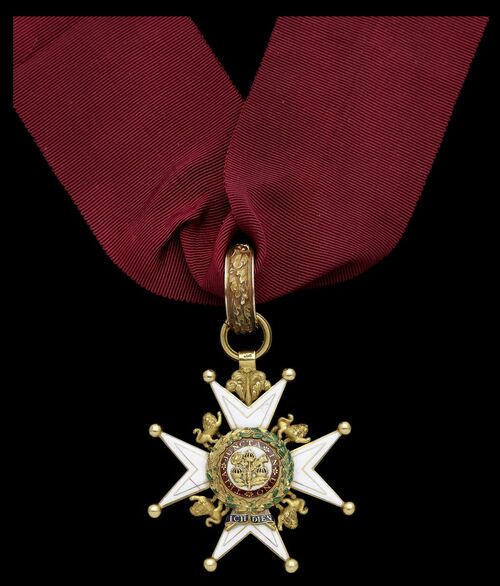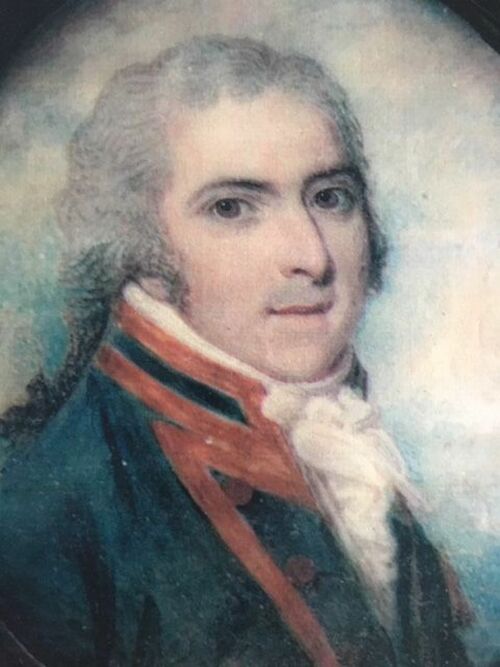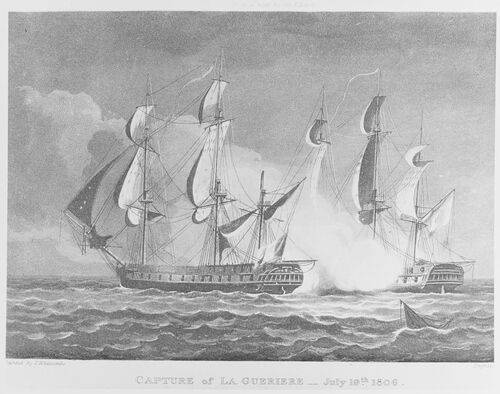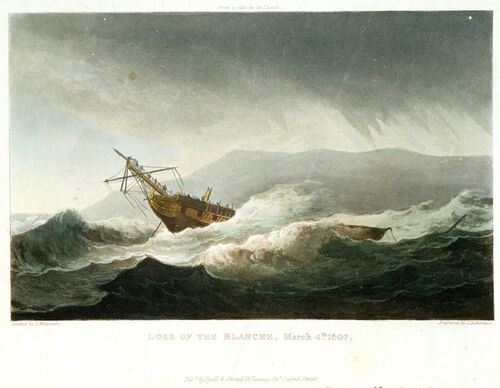Auction: 23001 - Orders, Decorations and Medals
Lot: 320
Sold by Order of a Direct Descendant
The K.C.B. neck Badge attributed to Captain Sir Thomas Lavie, Royal Navy, who was knighted for his command of H.M.S. Blanche upon the occasion when she captured the French frigate Guerriere off the Faroe Islands in July 1806
The Most Honourable Order of the Bath, K.C.B. (Military) Knight Commander’s neck Badge, gold and enamel, hallmarks for London 1814, some loss of green enamel to wreath, one or two very minor chips to enameled arms, otherwise good very fine
Provenance:
From the collection of Orders, Decorations and Medals awarded to members of the Lavie family, and thence by descent.
Thomas Lavie, son of Germain Lavie and Ann Gregg, was born in Putney on 16 October 1765 and first appears in the Naval Service as a Lieutenant on the books of H.M.S. Astrea, a 32-gun frigate. During Lavie's time with this ship and under the command of Captain Lord Henry Paulet, she took the French 42-gun vessel Gloire in an hour-long engagement; Paulet was awarded a Naval Gold Medal for this action, and as Lavie was promoted Master & Commander a few months later it is possible he too served in this action.
From 1796 through to 1800 Lavie was placed in command of several smaller vessels - namely the sloops H.M.S. Bittern and Seagull - before being promoted to Post Captain in January 1801. Though not appearing to remain actively employed during the Peace of Amiens (March 1802 - May 1803) Lavie clearly enjoyed an element of patronage at the highest levels within the Admiralty - no other personage than Lord St. Vincent requested he be appointed to a ship despite being "low on the post list" (Selections from the Correspondence of Admiral John Markham During the Years 1801-4 and 1806-7, p. 3, Navy Records Society, 1904, refers) - a stroke of extremely good fortune in such difficult times for officers of the armed forces. Despite this, Captain Lavie appears to have next been employed as commander of the 32-gun frigate H.M.S. Iris from the autumn of 1805, before removing in June of 1806 to H.M.S. Blanche, the 38-gun frigate in which he was shortly to make his name.
A Single-Ship Action, Capture, and Later Life
Lavie and Blanche were patrolling off the north-eastern coast of Britain with the objective of protecting merchant ships and trade routes from attack by French raiders and privateers when they received word of an enemy squadron in the area under orders for that very purpose. Sailing north from the Shetland Islands, on 18 July 1806 the French frigate Guerriere was spotted and Lavie made all sail to close with his opponent. The resulting battle was an exceptional result for the British captain and the men under his command: Guerriere failed to prepare for action (perhaps mistakenly believing the British frigate to be French) and by the time Guerriere began to fight back Blanche had already unleashed two broadsides into their opponent's hull. French gunnery appears to have been particularly bad on this occasion - not only did Blanche suffer minimal damage and a mere four men wounded - but conversely British gunnery was excellent, with Guerriere losing her mizzenmast in addition to having over fifty of her crew killed and wounded. Brought safely back to Britain, Lavie's reward was a knighthood and Guerriere was taken into the Royal Navy as H.M.S. Guerriere: she later met her end in a single-ship action against the famous American frigate U.S.S. Constitution.
Lavie (now Sir Thomas) continued in command of Blanche and saw further active service (capturing the George Washington in January 1807) - but on 4 March 1807 disaster struck: whilst en-route from Spithead to Brest to join Sir James Saumarez's blockading squadron, during a storm Blanche hit a submerged reef and swiftly began to break up. Thankfully Lavie and most of the crew survived, but were taken prisoner and spent the remainder of the Napoleonic Wars (some seven years) in French gaols.
Upon Lavie's release he was court-martialled as a matter of course for the loss of his ship, but exonerated from blame due to the court concluding that a large quantity of iron used in the interior construction of the ship, along with a significant number of firearms stored near the compass, caused an unforeseen navigational error. Though free from blame, Lavie appears not to have received another active command until the end of 1821 when he was appointed to the 74-gun H.M.S. Spencer; he was, however, one of the first naval officers to be appointed a Knight Commander of the Bath upon its' expansion in January 1815. Sadly Lavie's time in command of Spencer was short-lived as he died on 1 February 1822, aged just 56, at the Royal Naval Hospital, Plymouth, and was interred at Stoke Damerel. He had married Mary Sissmore in October 1797 and it appears that at least two of their six sons followed in their father's footsteps to become officers in the Royal Navy.
For the Medals awarded his great-grandson, Lieutenant Colonel H. E. Lavie, Yorkshire Regiment, please see Lot 372.
Subject to 20% VAT on Buyer’s Premium. For more information please view Terms and Conditions for Buyers.
Sold for
£21,000
Starting price
£2800











